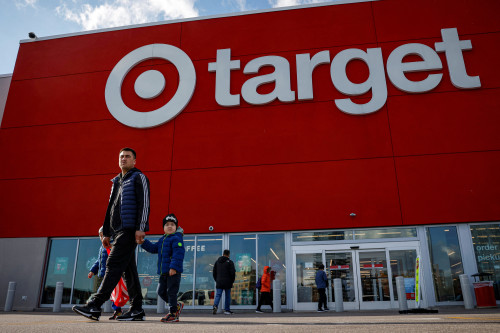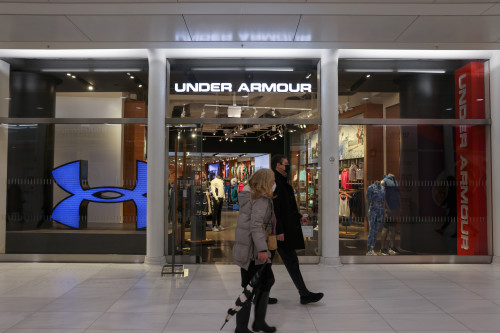By Siddharth Cavale and Ananya Mariam Rajesh
(Reuters) -Target slashed its annual sales forecast on Wednesday after posting a sharp fall in quarterly same-store sales, attributing the declines to weakened consumer confidence and a pullback in discretionary spending due to U.S. President Donald Trump’s tariff war.
Shares of the company were down 4.2% in volatile premarket trading after Target also said that its first-quarter performance was impacted by changes made to its diversity, equity and inclusion policies (DEI) in January.
The big-box retailer’s results showcase the pressure that American consumers are under due to growing economic concerns. In May, consumer sentiment slumped further while one-year inflation expectations surged. That followed the first contraction in the U.S. economy in three years in the first quarter due to a flood of imports as businesses and retailers raced to avoid higher costs from tariffs.
Target’s forecast on Wednesday was in contrast to bigger rival Walmart, which maintained its annual forecasts last week but said it would need to pass on higher prices to customers due to tariffs. That drew the ire of President Donald Trump, who said the retail giant should “eat the tariffs” on imported goods instead of passing on the costs to consumers.
Investors so far have not shown much confidence in Target’s strategy to focus on middle-income consumers and reliance on selling non-essential items. Its stock has performed poorly, down nearly 28% this year, in contrast to Walmart’s 9% gain and Home Depot’s 2.3% decline.
“Target’s (results) do nothing to restore confidence in the company. On the contrary, they are emblematic of a business that has made too many mistakes and has lost its way on several fronts,” GlobalData managing director Neil Saunders said, pointing to issues including a lack of exciting merchandise and poor inventory management.
Target executives did not say whether they would raise prices due to tariffs when asked about that on a call with reporters, stating only that it continuously adjusts pricing.
CEO Brian Cornell said current pricing decisions will largely depend on ongoing efforts to source more products in the United States and reduce reliance on China.
“That is going to play a very important role,” Cornell said.
Providing further details, Rick Gomez, the company’s chief commercial officer, said Target is working on several options including negotiating with suppliers, expanding sourcing to other Asian countries beyond China, re-evaluating its product assortment, and adjusting the timing and quantity of orders.
“These efforts are expected to offset the vast majority of the incremental tariff exposure,” Gomez said.
CHINA EXPOSURE
Target is coming off a year where it has struggled to deliver consistent sales growth, had issues with inventory management and more recently has faced boycotts and lawsuits related to its diversity, equity and inclusion practices.
CEO Brian Cornell said the reversal of some of its DEI policies played a role in its first-quarter performance, but that he couldn’t quantify the impact.
Unlike Walmart, which generates the bulk of revenue selling grocery items like bananas, milk, toilet paper, and shampoo, a majority of what Target sells falls in the non-essential category – largely apparel, home furnishing and beauty products, which it sources from China.
Target has previously said that it depends on China for 30% of its goods and that it is on track to reduce that to less than 25% by the end of the year. This is down from 60% in 2017, but still makes the current 30% tariff on China imports hard to navigate, analysts have said. Target has noted that about 50% of its cost of goods sold are made in the U.S.
Target said Wednesday it now expects a low-single digit decline in annual sales, a surprise for Wall Street analysts, who expected a 0.27% rise, according to LSEG. Target previously forecast net sales growth of around 1%.
The retailer expects annual adjusted earnings between $7.00 and $9.00 per share, compared to its prior forecast of $8.80 to $9.80. Analysts were expecting $8.40.
Several U.S. companies have either withdrawn, cut or withheld forecasts, citing the Trump administration’s on-and-off tariff strategy that has roiled global markets.
Target’s first-quarter comparable sales fell 3.8%, compared to analysts’ estimates of a 1.08% decline. On an adjusted basis, Target reported $1.30 per share. Analysts on average were expecting $1.61 per share.
(Reporting by Siddharth Cavale in New York and Ananya Mariam Rajesh in Bengaluru, Editing by Nick Zieminski)




